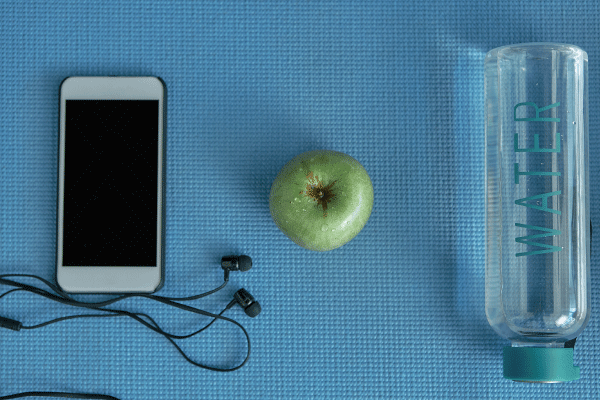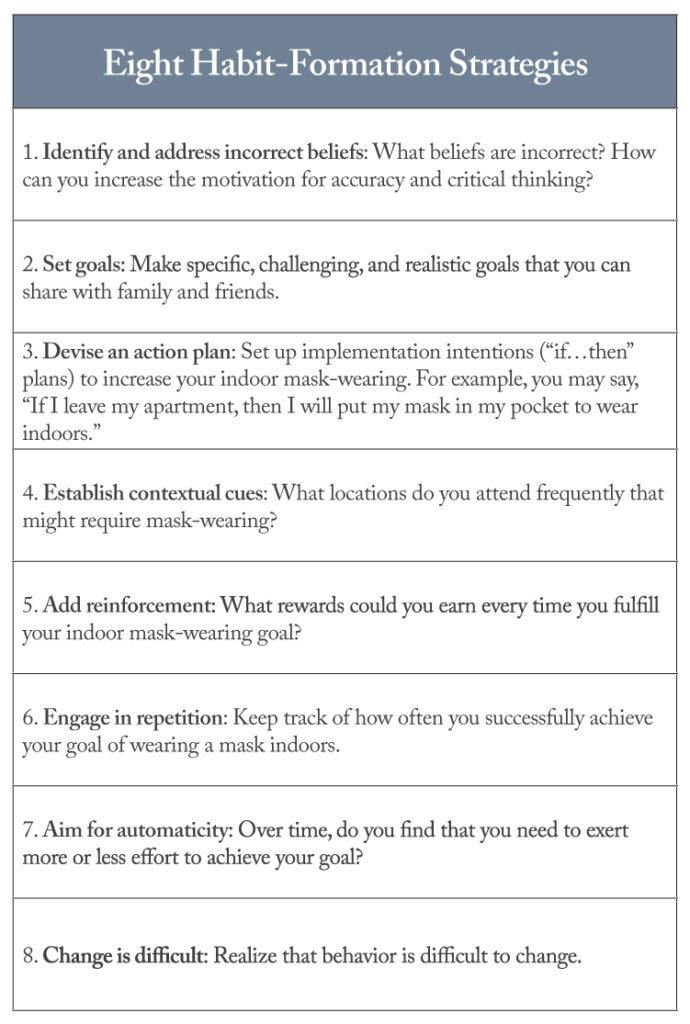Practice
Teaching: Healthy Habit Formation / Speaking With Strangers

Teaching Current Directions in Psychological Science offers advice and guidance about teaching a particular area of research or topic covered in this peer-reviewed APS bimonthly journal, which features reviews covering all of scientific psychology and its applications.
Edited by C. Nathan DeWall
How to Form Healthy Habits to Prevent COVID-19
The Sociable Science of Speaking with Strangers
How to Form Healthy Habits to Prevent COVID-19
By C. Nathan DeWall, University of Kentucky
The COVID-19 pandemic continues to wreak havoc on the world. Worldwide, more than 4 million people have died from COVID-19 (World Health Organization, 2021). Within the United States, more Americans died during the first 18 months of the COVID-19 pandemic than were killed in both World War I and World War II. Despite these widespread losses, some people refuse to take safe and effective vaccines. Others ignore laws that require them to wear face masks indoors. Why won’t people take precautions that could save their lives?

Student Activity: Masking Masks a Habit
This activity encourages students to use the science of habit formation to prevent COVID-19. Working in small groups, the class will develop a program to encourage people to wear face masks indoors, which reduces the spread of COVID-19 (Howard et al., 2021).
Divide the class into small groups of two to four students. Share psychologist Allison Harvey and colleagues’ (2021) definition of habit as “a learned action that is performed with minimal cognitive effort” (see also Lally & Gardner, 2003; Wood & Neal, 2007). Ask students to share some of their habits, such as how they remember to keep their smartphones nearby, brush their teeth regularly, or travel to and from class without getting lost.
Instruct students to imagine that a local community center has asked psychologists to meet individually with residents who want to develop habits to increase their indoor mask-wearing. Harvey and colleagues (2021) identified eight elements of habit formation that may help encourage behaviors that prevent COVID-19, including mask-wearing (see the table on the previous page). Tell the students their group will use these eight habit-formation strategies to design a program to increase mask-wearing indoors. Encourage them to keep in mind that the individuals participating in the program are motivated to wear masks indoors, and to be as creative as possible.
Give students at least 10 minutes to develop their habit-formation program. Time permitting, students can share their program with the class. Which strategies were the easiest to implement? Which were the most difficult? Why?
One possible reason is they haven’t formed effective habits, according to Allison Harvey, Courtney Armstrong, Catherine Callaway, Nicole Gumport, and Caitlin Gasperetti (2021). Before the pandemic, few people had protected themselves from a novel coronavirus. With little warning, people were thrust into a new world, one where they needed to develop new habits but, unlike in past attempts to change their behavior, could not afford to delay: Pandemics have no patience. To increase their chances of survival, people needed to quickly and effectively form the habits of wearing face masks and social distancing.
Harvey and colleagues (2021) applied the science of habit formation to inform interventions for COVID-19 prevention. They identified eight strategies that people may use to change their behaviors to reduce the spread of COVID-19 (see the table on the facing page). These strategies draw on dual-process models, learning, motivation, and social psychology. To be sure, no studies have directly supported or refuted Harvey and colleagues’ conceptual framework in the context of COVID-19 transmission. Time will tell whether the science of habit formation can help reduce the spread of COVID-19.
References
Howard, J., Huang, A., Zhiyuan, L., Tufekci, Z., Zdimal, V., van der Westhuizen, H.-M., von Delft, A., Price, A., Fridman, L. Tang, L.-H., Tang, V., Watson, G. L., Bax, C. E., Shaikh, R., Questier, F., Hernandez, D., Chu, L. F., & Rimoin, A. W. (2021). An evidence review of face masks against COVID-19. Proceedings of the National Academy of Sciences, USA, 118(4), Article e2014564118.
Lally, P., & Gardner, B. (2013). Promoting habit formation. Health Psychology Review, 7 (Suppl.), S137–S158.
World Health Organization. (2021). WHO coronavirus (COVID-19) dashboard. Retrieved on July 20, 2021, from https://covid19.who.int/.
Wood, W., & Neal, D. T. (2007). A new look at habits and the habit-goal interface. Psychological Review, 114(4), 843–863.
The Sociable Science of Speaking with Strangers
By David G. Myers, Hope College
We are social animals, as Aristotle surmised long ago, and as Paul Van Lange and Simon Columbus (2021) illustrate anew. Our distant ancestors, having survived by collectively hunting, sharing, and protecting, endowed us with a need to belong. Separated from those we love, by a foreign sojourn or ostracism or death, we feel the loss. Small wonder that mental health suffered during the COVID-19 pandemic’s social isolation (Abbott, 2021). Blessed with social support from caring attachments, we tend to live with greater health and happiness.
Student Activity: Micro-Friendships
This science of micro-friendships could make for an inspiring class. As an activity, students could be assigned to replicate the experience of those in the micro-interaction experiments. When interacting with a store clerk, crossing paths with a building custodian, or entering the dining hall, pause to (as in the barista experiment) “smile, make eye contact to establish a connection, and have a brief conversation.” Take note: Having done so, how did you feel? How did the recipient of your attention seem to feel?
Alternatively, instructors could pair students for a here-and-now connection, asking each to choose one or two nonthreatening but revealing questions to answer. Here are some possibilities from the 36 used by Arthur Aron and his colleagues (1997) to create closeness between strangers: For what in your life do you feel most grateful? What would constitute a “perfect” day for you? What is your most treasured memory? Again, afterward, invite students to report how they expected to feel before they asked the question (awkward?) and how they actually feel now.
Or instructors could ask students, as I did my Facebook friends: Can you recall happy experiences of humanizing brief interactions—either as a giver or a receiver?
In response, dozens of examples flowed in. People recalled, as students surely could as well, the gratifying results of reaching out to homeless people, taxi drivers, restaurant servers, and fellow hikers, dog walkers, and campers.
Some recalled being blessed by another’s reaching out. One woman, stressed by managing a clinic at the beginning of the COVID-19 pandemic, stopped by a convenience store to console herself with “a family sized bag of chocolate.” The cashier, “a young 20-something man, asked me if I’d come all the way to the store just for chocolate. I said yes, it had been a bad day. He then asked me why and I just burst into tears. His genuine interest and compassion were so validating and humanizing that the floodgates broke. He probably thought he made my day worse . . . but he really made my day better and I think I will never forget the kindness of this young guy toward a hot mess 40-something mom.”
Others recalled being blessed by another’s response to their reaching out. One man recalled that “When I was a college student, I used to smile and greet the only other dark-skinned Mexican on campus (a small California college). The other students used to mock him for his [older] age, quirky personality, and appearance. We never had classes together so I never really got to know him. But at graduation he approached me tearfully and thanked me for my frequent smiles and greetings. He told me that often it was the only kindness he would experience for long periods at the college, and that it helped him get through.”
The bottom line: The simple story of the micro-friendship experiments can combine with students’ own real-life experiences to instill an important lesson: Our reaching out to strangers—micro-prosociality—brightens others’ days. And it brightens our own.
That much you already know, and know to teach. But what about our fleeting interactions—brief hallway chats, blathering with a rideshare driver, bantering with our baristas? Do these fleeting micro-connections also pay social-emotional dividends?
Yes indeed, say Van Lange and Columbus. They support this assertion with three propositions:
- Most interactions with strangers are benign. As in a clerk/customer encounter, the transaction commonly engages complimentary interests, mutual dependence, and equality of power—situations that are conducive to prosocial behavior (Columbus et al., 2021).
- Most strangers are benign—or even benevolent. If a hotel buffet has several cold cuts left, but only one ham slice remains, many folks, being “socially mindful,” will leave it for others. With Niels Van Doesum and Dion Van Lange, Paul Van Lange (2013) simulated such kindness in experiments that invited people to choose one of three available items, such as pens or baseball caps, as a gift. When a set included two identical items (say, two black pens and one blue pen), people usually selected one of the duplicates—to preserve the same choice for a stranger who followed them.
- Most interactions with strangers enhance well-being. Strong ties with family and friends support our health and well-being, but even fleeting, weak ties are socially adaptive and induce happiness. Such is the clear and consistent result of simple experiments in which some people but not others have to socially engage a stranger—to smile, chat, and make eye contact with a barista (Sandstrom & Dunn, 2014); to strike up a conversation with a fellow commuter-train or bus passenger (Epley & Schroeder, 2014); to offer unexpected compliments to a passerby (Boothby & Bohns, 2021); or to smile and say a friendly word to a campus shuttle driver (Gunaydin et al., 2020). In each case, the friendly interaction brightened the participants’ moods (and, in Epley and Schroeder’s study, did so equally for extraverts and introverts).
References
Abbott, A. (2021). COVID’s mental-health toll: How scientists are tracking a surge in depression. Nature, 590, 194–195.
Aron, A., Melinat, E., Aron, E. N., Vallone, R. D., & Bator, R. J. (1997). The experimental generation of interpersonal closeness: A procedure and some preliminary findings. Personality and Social Psychology Bulletin, 23(4), 363–377.
Boothby, E., & Bohns, V. (2021). Why a simple act of kindness is not as simple as it seems: Underestimating the positive impact of our compliments on others. Personality and Social Psychology Bulletin 47(5), 826–840.
Columbus, S., Molho, C., Righetti, F., & Balliet, D. (2021). Interdependence and cooperation in daily life. Journal of Personality and Social Psychology, 120(3), 626–650.
Epley, N., & Schroeder, J. (2014). Mistakenly seeking solitude. Journal of Experimental Psychology: General, 143(5), 1980–1999.
Gunaydin, G., Oztekin, H., Karabulut, D. H., & Salman-Engin, S. (2020). Minimal social interactions with strangers predict greater subjective well-being. Journal of Happiness Studies 22, 1839–1853.
Sandstrom, G. M., & Dunn, E. W. (2014). Is efficiency overrated? Minimal social interactions lead to belonging and positive affect. Social Psychological and Personality Science, 5(4), 437–442.
Van Doesum, N. J., Van Lange, Dion A. W., & Van Lange, Paul A. M. (2013). Social mindfulness: Skill and will to navigate the social world. Journal of Personality and Social Psychology, 105(1), 86–103.





APS regularly opens certain online articles for discussion on our website. Effective February 2021, you must be a logged-in APS member to post comments. By posting a comment, you agree to our Community Guidelines and the display of your profile information, including your name and affiliation. Any opinions, findings, conclusions, or recommendations present in article comments are those of the writers and do not necessarily reflect the views of APS or the article’s author. For more information, please see our Community Guidelines.
Please login with your APS account to comment.